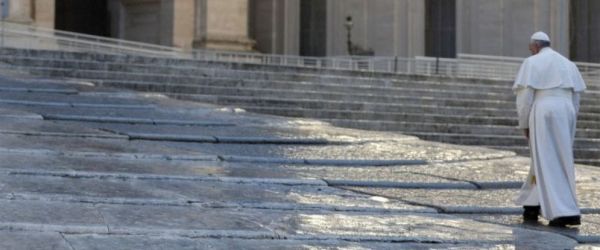To pray, to celebrate, to imitate Jesus: these are the three 'doors' - to be opened to find 'the way, to go to the truth and to life' - that Pope Francis pointed out this morning, Friday 16 May, during the Mass in the chapel of the Santa Marta house. According to the Pontiff, in fact, Jesus does not allow himself to be studied at a desk, and those who try to do so risk slipping into heresy. On the contrary, we must continually ask ourselves how prayer, celebration and imitation of Christ go in our lives. "Let us think of these three doors and they will do us all good," he said, suggesting that we begin by reading the book of the Gospel, which too often remains "full of dust, because it is never opened. Take it, open it - he urged - and you will find Jesus".
After recalling that the previous reflection had focused on the fact that "the Christian life is always to go on the road and not to go alone", always "in the Church, in the people of God", the bishop of Rome pointed out how in the liturgical readings of the day - taken from the Acts of the Apostles (13, 26-33) and the Gospel of John (14 1, 6) - it is Jesus himself who tells us "that he is the way: I am the way, the truth and the life. Everything. I give you life, I manifest myself as truth, and if you come with me, I am the way". So, to know the one who presents himself "as the way, the truth and the life", one must set out on "a journey". Indeed, according to Pope Francis, "the knowledge of Jesus is the most important work of our lives". Also because by knowing him one comes to know the Father.
But, the Pontiff wondered, "how can we know Jesus?". With those who reply that "one must study a lot", the bishop of Rome agreed and invited to "study the catechism: a beautiful book, the Catechism of the Catholic Church, we must study it". But, he immediately added, one cannot limit oneself to "believing that we will know Jesus only through study". Some, in fact, have "this fantasy that ideas, only ideas, will lead us to the knowledge of Jesus". Even "among the first Christians" some thought in this way "and in the end they ended up a bit tangled up in their thoughts". Because 'ideas alone do not give life' and, therefore, those who go down this road 'end up in a labyrinth' from which 'they no longer come out'. Precisely for this reason, from the very beginning, in the Church 'there are heresies', which are this 'trying to understand only with our minds who Jesus is'. In this regard, the Pope recalled the words of "a great English writer", Gilbert Keith Chesterton, who called heresy an idea gone mad. In fact, said the Pope, "it is like this: when ideas are alone, they become crazy".
Hence the indication of the three doors to be opened to "know Jesus". Dwelling on the first - praying - the Pontiff reiterated that "study without prayer is of no use. The great theologians do theology on their knees'. If in fact 'with study we come a little closer, without prayer we will never know Jesus'.
As for the second - celebrating - the bishop of Rome said that even prayer alone "is not enough; the joy of celebration is necessary: celebrating Jesus in his sacraments, because there he gives us life, he gives us strength, he gives us the meal, he gives us comfort, he gives us the covenant, he gives us the mission. Without the celebration of the sacraments we do not come to know Jesus. And this is proper to the Church'.
Finally, in order to open the third door, that of the imitatio Christi, the task is to take the Gospel to discover "what he did, what his life was like, what he told us, what he taught us", so as to "try to imitate him". In conclusion, the Pope explained that passing through these three doors means "entering into the mystery of Jesus". For we 'can only know him if we are able to enter into his mystery'. And we must not be afraid to do so.
At the end of his homily, Pope Francis then invited us to think "during the day, how the door of prayer goes in my life: but - he specified - the prayer of the heart" the true one.
[Pope Francis, S. Marta homily, in L'Osservatore Romano 17/05/2014]












